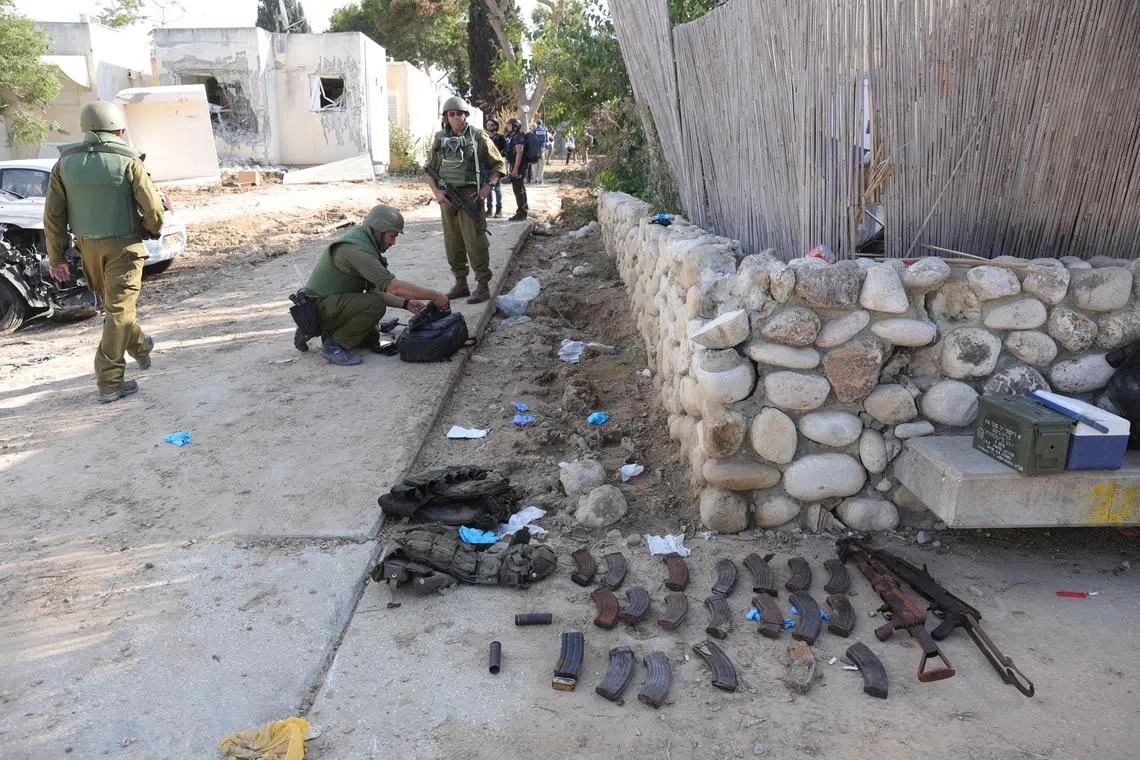Hamas weapons, tactics resemble those of North Korea, say South Korea’s Joint Chiefs of Staff
Sign up now: Get ST's newsletters delivered to your inbox

Hamas had previously employed tactics that centred on hit-and-run attacks, and also engaged in small-scale conflicts and rocket attacks.
PHOTO: EPA-EFE
Follow topic:
SEOUL – The South Korean military has assessed that the fighting doctrine and tactics utilised by Hamas might be linked to North Korea, citing their resemblance in its analysis of the battlefield tactics employed by the Palestinian militant group during the attack on Israel earlier in October.
South Korea’s Joint Chiefs of Staff (JCS) on Tuesday presented its interim evaluation of the ongoing war between Israel and Hamas, which was initiated by Hamas’ surprise attack on Israel on Oct 7.
“Our assessment of the situation has unveiled both direct and indirect ties between Hamas and North Korea, spanning various aspects including arms trade, tactics, doctrine and training,” the JCS stated in its evaluation.
The South Korean military has concluded that North Korea may have contributed to Hamas, an organisation classified as a terrorist group by the United States and other Western countries, in preparing for a large-scale attack employing distinct tactics different from those used in previous battlefields.
Hamas had previously employed tactics that centred on hit-and-run attacks, and also engaged in small-scale conflicts and rocket attacks.
But at the Oct 7 weekend, Hamas carried out unexpected attacks during holiday periods and launched a significant number of rockets to overpower Israel’s Iron Dome missile defence system.
In addition, the group conducted drone attacks
“Hamas’ attack methods resemble the ‘asymmetric attack pattern’ we anticipate from North Korea. Therefore, we presume that there is a possibility of North Korea transferring tactics and doctrine, as well as providing training support, based on this observation,” the JCS said.
North Korea has faced constraints regarding covert ground infiltration, largely due to South Korea’s deployment of an unmanned border security system in the mid-2010s, according to the JCS. In response, North Korea has intensified its training for aerial infiltration using paragliders.
For instance, in December 2016, under the direct guidance of North Korean leader Kim Jong Un, the North publicly conducted exercises involving paragliders with the South Korean presidential office as the target.
The South Korean military expressed concerns, emphasising that there is a possibility of such expertise being transferred to Hamas, which utilised paragliders to infiltrate Israel from the Gaza Strip.
The South Korean military did not provide concrete evidence and intelligence that could prove a direct link between Hamas and North Korea. Nevertheless, it suggested the possibility of an indirect interaction.
“North Korea has substantial and active interactions with several Middle Eastern countries and various armed groups that have close relationships with Hamas,” one JCS official, who wished to remain anonymous, said during a closed-door briefing.
The official cited Iran, Syria and Hezbollah, an Iranian-backed Lebanese Shi’ite organisation, as examples.
“Consequently, there is a possibility that (the doctrine and tactics) could have been indirectly passed on to Hamas and subsequently adopted by them, taking into account these dynamics.”
The JCS also pointed to a potential weapons trade.
The photos recently released by the media and the Israel Defence Forces suggested that Hamas used 85mm F-7 surface-to-surface high-explosive fragmentation rockets produced in North Korea during its attacks on Israel. Additionally, North Korean-made 122mm artillery shells, presumed to be weapons used by armed groups actively supporting or affiliated with Hamas, have been discovered in the vicinity of the Israeli border.
“These findings indicate an ongoing pattern of North Korea exporting various weapons to Middle Eastern countries and armed groups,” the JCS said. However, the JCS clarified that it could not find evidence of weapons being directly exported from North Korea to Hamas.
Nevertheless, it suggested that these weapons may find their way to Hamas through intermediaries, which could include Iran, Syria and Hezbollah, in active military exchanges with North Korea.
The JCS reiterated its warning, stating there is a “high chance that North Korea will employ ‘Hamas-style’ surprise attack tactics, which have proven effective in recent situations, in potential attacks against South Korea in the event of contingencies”.
The JCS acknowledged the differences between Hamas, a non-state organisation, and North Korea in terms of wartime goals and battlefield situations.
“While North Korea’s situation, terrain and conditions may differ, and their combat capabilities are not identical, the country can certainly gain valuable insights and lessons from what has transpired,” the unnamed senior official stated during the briefing when asked by The Korea Herald whether nuclear-armed North Korea might adopt Hamas’ tactics, despite the differences.
The official clarified that North Korea’s conventional forces still possess effective capabilities, even in the face of the country’s potential use of nuclear weapons in contingency scenarios. North Korea has overtly declared its intent to utilise tactical nuclear weapons designed for the battlefield, including pre-emptive use in specific circumstances.
“Using nuclear weapons is a challenging decision, and consequently, there is a significant opportunity for North Korea to derive lessons from the utilisation of their conventional forces, potentially leveraging these lessons to their advantage.”
The South Korean military has affirmed its commitment to systematically enhancing and evolving its response strategies by drawing valuable insights from a comprehensive analysis of the Israel-Hamas war. THE KOREA HERALD/ASIA NEWS NETWORK

